Application of sammāvāyāma to develop quality of life in today's society according to the principles of Buddhism
Main Article Content
Abstract
This article aims to study “Application of Sammāvāyāma to develop quality of life in today's society according to the principles of Buddhism.” It showed that Sammāvāyāma, an ethical principle in the Noble Eightfold Path, signifies a commitment or endeavor towards moral rectitude which involves: 1) the effort to prevent unwholesome states of mind from arising, 2) the effort to let go of existing unwholesome states of mind, 3) the effort to cultivate wholesome states of mind that have not yet arisen, and 4) the effort to sustain wholesome states of mind that have arisen. Sammāvāyāma aligns with the teachings of Buddhism and comprises three objectives: benefits in the present life, in future lives, and for spiritual progress. Regarding the application of Sammāvāyāma for personal development, it can be categorized into four dimensions: 1) educational dimension, which emphasizes consistent learning and teaching of precepts and practices with the goal of self-discipline, 2) occupational dimension, which promotes diligence, conscientiousness, and non-deception in work while nurturing ethical attitudes, 3) self-development dimension, which involves physical and mental growth following the principles of discipline, and 4) ethical dimension, which utilizes Sammāvāyāma to suppress unwholesomeness and instigate virtue through the practice of abstaining from desires, divided into two categories: 1)Saḷegha, gradual suppression of desires, and 2) Tuttāṅgha, forceful suppression with immediate effects.
Article Details

This work is licensed under a Creative Commons Attribution-NonCommercial-NoDerivatives 4.0 International License.
Copyright Notice
The content and information in the articles published in Journal of MCU Palisueksabuddhaghosa Review, are regarded as opinions and responsibilities of article author only. It definitely does not mean that the editor must agree or share any responsibility to the author.
Articles, information, content, figure etc. that have been published in the Journal of MCU Palisueksabuddhaghosa Review is considered as the copyright of the Journal. If any individual or organization will to bring any parts of article for promote or to do anything, must be licensed only in official form from the Journal of MCU Palisueksabuddhaghosa Review.
The content and information in the articles published in Journal of MCU Palisueksabuddhaghosa Review, are regarded as opinions and responsibilities of article author only. It definitely does not mean that the editor must agree or share any responsibility to the author.
Articles, information, content, figure etc. that have been published in the Journal of MCU Palisueksabuddhaghosa Review is considered as the copyright of the Journal. If any individual or organization will to bring any parts of article for promote or to do anything, must be licensed only in official form from the Journal of MCU Palisueksabuddhaghosa Review.
References
ประเสริฐ อุทัยเฉลิม. (๒๕๕๔). กลัวเกิดไม่กลัวตาย. สมุทรปราการ: ชมรมกัลป์ยาณธรรม.
พระธรรมปิฎก. (ป.อ. ปยุตฺโต). (2546). รุ่งอรุณของการศึกษา เบิกฟ้าแห่งการพัฒนาที่ยั่งยืน. พิมพ์ครั้งที่ ๓. กรุงเทพมหานคร : มูลนิธิพุทธธรรม.
________. (2539). ลักษณะแห่งพระพุทธศาสนา. กรุงเทพมหานคร: มูลนิธิพุทธธรรม.
________. (2545). พจนานุกรมพุทธศาสตร์ฉบับประมวลธรรม. .กรุงเทพมหานคร: บริษัทสื่อตะวัน.
พระพรหมคุณาภรณ์. (ป.อ. ปยุตฺโต). (2553). ปฏิบัติธรรมให้ถูกทาง. พิมพ์ครั้งที่ ๘๖. กรุงเทพมหานคร : สหธรรมิก จำกัด.
________. (2558). พจนานุกรมพุทธศาสตร์ ฉบับประมวลธรรม. กรุงเทพมหานคร: สำนักพิมพ์ผลิธรรม.
________. (2556). พจนานุกรมพุทธศาสตร์ ฉบับประมวลศัพท์. พิมพ์ครั้งที่ 26. กรุงเทพมหานคร : สหธรรมิก จำกัด.
พระมหาจรรยา สุทฺธิาโณ. (๒๕๔๔). ธรรมทรรศน์ปฏิวัติการศึกษา. กรุงเทพมหานคร : ประชาธรรม.
พระอาจารย์ชา สุภทฺโท. (๒๕๔๑). นอกเหตุเหนือผล. กรุงเทพมหานคร: คุรุสภาลาดพร้าว.
พุทธทาสภิกขุ. (๒๕๓๐). ความกลัว: พุทธศาสนา ศาสนาแห่งการบังคับตัวเอง. กรุงเทพมหานคร: ไทยวัฒนาพานิช.
________. (2550). โพธิปักขิยธรรมประยุกต์. กรุงเทพมหานคร: บริษัทตถาตา พับลิเคชั่น จำกัด.
มหาจุฬาลงกรณราชวิทยาลัย. .(2535). พระไตรปิฎกภาษาบาลี. ฉบับมหาจุฬาเตปิฏกํ. 2500. กรุงเทพมหานคร : หาจุฬาลงกรณราชวิทยาลัย.
________. (2539). พระไตรปิฎกภาษาไทย. ฉบับมหาจุฬาลงกรณราชวิทยาลัย. กรุงเทพมหานคร : มหาจุฬาลงกรณราชวิทยาลัย.
ราชบัณฑิตยสถาน. (2556). พจนานุกรม ฉบับราชบัณฑิตยสถาน พ.ศ. 2554. กรุงเทพมหานคร : บริษัท ศิริวัฒนาอินเตอร์ปริ้นท์ จำกัด.
________. (๒๕๔๖). พจนานุกรมฉบับราชบัณฑิตยสถานพ.ศ. ๒๕๔๒. กรุงเทพมหานคร : บริษัท นานมีบุ๊คส์พับลิเคชั่นส์.
สุวรรณ เพชรนิล. (๒๕๓๙). พุทธปรัชญาเบื้องต้น. ภาควิชาปรัชญา คณะมนุษยศาสตร์: มหาวิทยลัยรามคำแหง.


